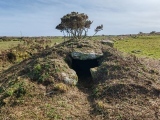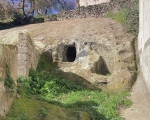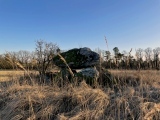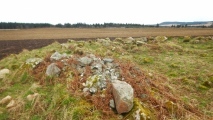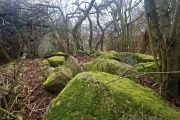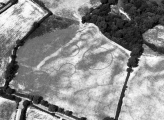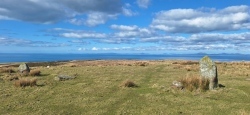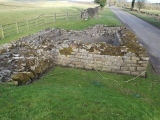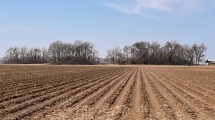Andy Burnham's Blog, page 30
March 23, 2025
Treen Entrance Grave (SW)
A nicely cleared Megalithic Tomb with a Mohican haircut - whatever next!. This tomb is one of four tombs and barrows, two of which are Scillonian entrance graves. The others are too mutilated to know whether they contained a chamber. The best preserved is this Treen Entrance Grave (SE) which is a mound 25' across and 4'6" high with a 13' long, 3' high and 4' wide chamber on its northern side. The orientation of the chamber marks the midwinter sun over Carn Galva.
Published on March 23, 2025 05:52
March 22, 2025
S'Angrone Domus de Janas
In the village of Nughedu Santa Vittoria, Sardinia there are some domus de janas - survivors of a larger necropolis destroyed to build houses over the centuries. One tomb is very interesting as it preserves peculiar architectural and decorative elements, like a pillar with relief decoration, representing a bull's head (according to some scholars an upside-down anthropomorphic figure). On the walls we can see decorative motifs in relief, in the form of panels and a false door, with remains of red paint.
Published on March 22, 2025 11:00
Østerballe Runddysse
First photos of this dolmen, originally spied from the bus window coming home from Grenaa, far out in a field on a little knoll - see the visit log and caption to Vishap's photo - well spotted all!. A round shaped dolmen in Randers, approx. 10 m in diameter, with a burial chamber formed by five orthostats (upright stones), one capstone and two pairs of footstones. Only one of the kerb stones is visible.
Published on March 22, 2025 05:09
March 19, 2025
Easter Clune 1
This Clava ring-cairn measures 22m in diameter and the edged kerb of boulders around the perimeter are incomplete but still evident. No standing stones remain. Easter Clune is thought to be one of four Clava Cairns in the vicinity: Golford (no remains), Auldern (three remaining stones) and Moyness, a half complete edge of stones with a single monolith.
Published on March 19, 2025 08:17
Kalby Langdysse 2
Langdysse (Long Barrow) in Præstø. The remains of a mound, wooded in a field with a four-sided chamber. There are four orthostats and one capstone which has been overturned. It is oriented NE to SW. Towards the NE is another capstone and two smaller stones, perhaps the remains of another chamber.
Published on March 19, 2025 08:04
March 18, 2025
Ffynnongroes or Crosswell Barrow Cemetery
Tim Daw writes: This is the site that Mike Parker Pearson's team has been, and will continue to, excavate. The three aligned rings appear to be aligned to the Mid Summer Solstitial Sunrise. In recent talks he has outlined that underneath the bronze age ditches there are older ones, and under the banks there are stone sockets. Intriguing, the publication of the results and analysis are eagerly awaited. Could it be the missing bluestone circle?
Published on March 18, 2025 11:33
March 16, 2025
Waun Oer
This row has amazing views of the Lleyn peninsula. It consists of up to 10 large, small and medium stones, three of which may be natural rocks, and two of which have probably been moved or relocated. Sandy Gerrard has proposed a series of 'Landmark Reveals' in which landscape features disappear and reappear as you move along the alignment. There may be a cupmark on one of the stones.
Published on March 16, 2025 10:13
Bwlch y Ddeufaen N
Standing Stone in Conwy. This northerly stone is smaller and more angular than its southerly friend. Lichen has turned it a lovely green colour. The adjacent pylon detracts from the ambience. (unless you like pylons!)
Published on March 16, 2025 10:04
March 15, 2025
Turret 51B
Published on March 15, 2025 10:39
March 14, 2025
Transylvania Mound
Transylvania may have had as many as twelve mounds that formed two plazas, with the largest mound shared by each plaza. Mapping in 2000 identified six remaining mounds. The tallest mound is 10m (34 feet) high, with the others that remain at 5.5m (18 ft), 2.7m (9 ft), 2m (6 1⁄2 ft) and the others less than thisl. 2m mound has a barn on top and was modified for the building. Other mounds are no longer visible because their smaller size may have made them more vulnerable to ploughing. Testing in the 1960s indicated that occupation began about AD 700–1200 (Coles Creek period), and ceramics recovered from the site date to AD 1200–1541 (Plaquemine/Mississippi period). A radiocarbon sample near one of the mounds dates to between AD 1048 and 1411.
Published on March 14, 2025 06:11

